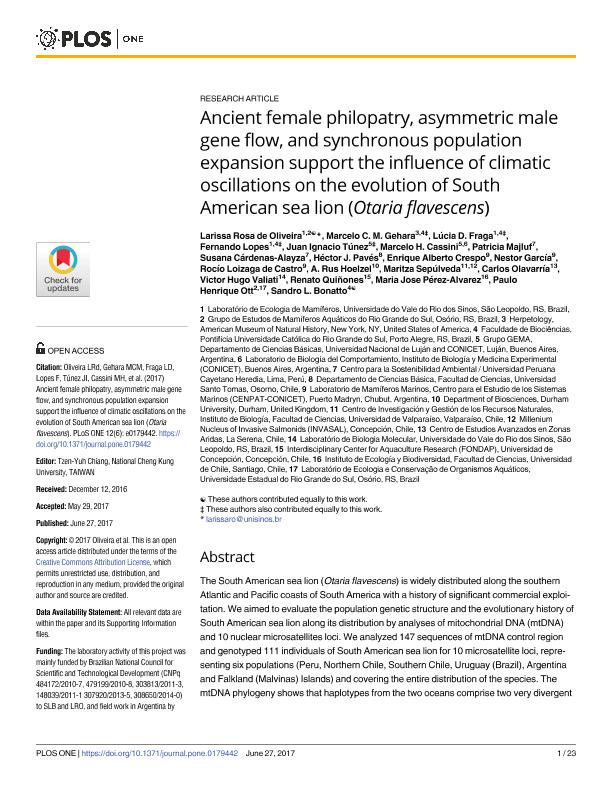Mostrar el registro sencillo del ítem
dc.contributor.author
Rosa de Oliveira, Larissa

dc.contributor.author
Gehara, Marcelo C. M.
dc.contributor.author
Fraga, Lúcia D.
dc.contributor.author
Lopes, Fernando
dc.contributor.author
Tunez, Juan Ignacio

dc.contributor.author
Cassini, Marcelo Hernan

dc.contributor.author
Majluf, Patricia
dc.contributor.author
Cárdenas Alayza, Susana
dc.contributor.author
Pavés, Héctor J.
dc.contributor.author
Crespo, Enrique Alberto

dc.contributor.author
Garcia, Nestor Anibal

dc.contributor.author
Loizaga de Castro, Rocio

dc.contributor.author
Hoelzel, A. Rus
dc.contributor.author
Sepúlveda, Maritza
dc.contributor.author
Olavarría, Carlos

dc.contributor.author
Valiati, Victor Hugo
dc.contributor.author
Quiñones, Renato
dc.contributor.author
Pérez Alvarez, Maria Jose
dc.contributor.author
Ott, Paulo Henrique
dc.contributor.author
Bonatto, Sandro Luis

dc.date.available
2018-05-08T19:17:32Z
dc.date.issued
2017-06
dc.identifier.citation
Rosa de Oliveira, Larissa; Gehara, Marcelo C. M.; Fraga, Lúcia D.; Lopes, Fernando; Tunez, Juan Ignacio; et al.; Ancient female philopatry, asymmetric male gene flow, and synchronous population expansion support the influence of climatic oscillations on the evolution of South American sea lion (Otaria flavescens); Public Library of Science; Plos One; 12; 6; 6-2017; e0179442
dc.identifier.issn
1932-6203
dc.identifier.uri
http://hdl.handle.net/11336/44478
dc.description.abstract
The South American sea lion (Otaria flavescens) is widely distributed along the southern Atlantic and Pacific coasts of South America with a history of significant commercial exploitation. We aimed to evaluate the population genetic structure and the evolutionary history of South American sea lion along its distribution by analyses of mitochondrial DNA (mtDNA) and 10 nuclear microsatellites loci. We analyzed 147 sequences of mtDNA control region and genotyped 111 individuals of South American sea lion for 10 microsatellite loci, representing six populations (Peru, Northern Chile, Southern Chile, Uruguay (Brazil), Argentina and Falkland (Malvinas) Islands) and covering the entire distribution of the species. The mtDNA phylogeny shows that haplotypes from the two oceans comprise two very divergent clades as observed in previous studies, suggesting a long period (>1 million years) of low inter-oceanic female gene flow. Bayesian analysis of bi-parental genetic diversity supports significant (but less pronounced than mitochondrial) genetic structure between Pacific and Atlantic populations, although also suggested some inter-oceanic gene flow mediated by males. Higher male migration rates were found in the intra-oceanic population comparisons, supporting very high female philopatry in the species. Demographic analyses showed that populations from both oceans went through a large population expansion ~10,000 years ago, suggesting a very similar influence of historical environmental factors, such as the last glacial cycle, on both regions. Our results support the proposition that the Pacific and Atlantic populations of the South American sea lion should be considered distinct evolutionarily significant units, with at least two managements units in each ocean.
dc.format
application/pdf
dc.language.iso
eng
dc.publisher
Public Library of Science

dc.rights
info:eu-repo/semantics/openAccess
dc.rights.uri
https://creativecommons.org/licenses/by-nc-sa/2.5/ar/
dc.subject
Pinnipedos
dc.subject
Molecular Markers
dc.subject
Female Philopatry
dc.subject
Phylogeography
dc.subject.classification
Otras Ciencias Biológicas

dc.subject.classification
Ciencias Biológicas

dc.subject.classification
CIENCIAS NATURALES Y EXACTAS

dc.title
Ancient female philopatry, asymmetric male gene flow, and synchronous population expansion support the influence of climatic oscillations on the evolution of South American sea lion (Otaria flavescens)
dc.type
info:eu-repo/semantics/article
dc.type
info:ar-repo/semantics/artículo
dc.type
info:eu-repo/semantics/publishedVersion
dc.date.updated
2018-04-05T13:46:01Z
dc.journal.volume
12
dc.journal.number
6
dc.journal.pagination
e0179442
dc.journal.pais
Estados Unidos

dc.journal.ciudad
San Francisco
dc.description.fil
Fil: Rosa de Oliveira, Larissa. Universidade do Vale do Rio dos Sinos; Brasil. Grupo de Estudos de Mamíferos Aquáticos do Rio Grande do Sul; Brasil
dc.description.fil
Fil: Gehara, Marcelo C. M.. American Museum Of Natural History; Estados Unidos. Pontificia Universidade Católica do Rio Grande do Sul; Brasil
dc.description.fil
Fil: Fraga, Lúcia D.. Universidade do Vale do Rio dos Sinos; Brasil. Pontificia Universidade Católica do Rio Grande do Sul; Brasil
dc.description.fil
Fil: Lopes, Fernando. Universidade do Vale do Rio dos Sinos; Brasil. Pontificia Universidade Católica do Rio Grande do Sul; Brasil
dc.description.fil
Fil: Tunez, Juan Ignacio. Consejo Nacional de Investigaciones Científicas y Técnicas; Argentina. Universidad Nacional de Luján; Argentina
dc.description.fil
Fil: Cassini, Marcelo Hernan. Consejo Nacional de Investigaciones Científicas y Técnicas. Instituto de Biología y Medicina Experimental. Fundación de Instituto de Biología y Medicina Experimental. Instituto de Biología y Medicina Experimental; Argentina. Universidad Nacional de Luján; Argentina
dc.description.fil
Fil: Majluf, Patricia. Universidad Peruana Cayetano Heredia; Perú
dc.description.fil
Fil: Cárdenas Alayza, Susana. Universidad Peruana Cayetano Heredia; Perú
dc.description.fil
Fil: Pavés, Héctor J.. Universidad Santo Tomas; Chile
dc.description.fil
Fil: Crespo, Enrique Alberto. Consejo Nacional de Investigaciones Científicas y Técnicas. Centro Científico Tecnológico Conicet - Centro Nacional Patagónico. Centro para el Estudio de Sistemas Marinos; Argentina
dc.description.fil
Fil: Garcia, Nestor Anibal. Consejo Nacional de Investigaciones Científicas y Técnicas. Centro Científico Tecnológico Conicet - Centro Nacional Patagónico. Centro para el Estudio de Sistemas Marinos; Argentina
dc.description.fil
Fil: Loizaga de Castro, Rocio. Consejo Nacional de Investigaciones Científicas y Técnicas. Centro Científico Tecnológico Conicet - Centro Nacional Patagónico. Centro para el Estudio de Sistemas Marinos; Argentina
dc.description.fil
Fil: Hoelzel, A. Rus. University Of Durham; Reino Unido
dc.description.fil
Fil: Sepúlveda, Maritza. Facultad de Ciencias, Universidad de Valparaíso; Chile. Millenium Nucleus of Invasive Salmonids; Chile
dc.description.fil
Fil: Olavarría, Carlos. Centro de Estudios Avanzados en Zonas Aridas; Chile
dc.description.fil
Fil: Valiati, Victor Hugo. Universidade do Vale do Rio dos Sinos; Brasil
dc.description.fil
Fil: Quiñones, Renato. Universidad de Concepción; Chile
dc.description.fil
Fil: Pérez Alvarez, Maria Jose. Universidad de Chile; Chile
dc.description.fil
Fil: Ott, Paulo Henrique. Grupo de Estudos de Mamíferos Aquáticos do Rio Grande do Sul; Brasil. Universidade Estadual do Rio Grande do Sul; Brasil
dc.description.fil
Fil: Bonatto, Sandro Luis. Pontificia Universidade Católica do Rio Grande do Sul; Brasil
dc.journal.title
Plos One

dc.relation.alternativeid
info:eu-repo/semantics/altIdentifier/doi/http://dx.doi.org/10.1371/journal.pone.0179442
dc.relation.alternativeid
info:eu-repo/semantics/altIdentifier/url/http://journals.plos.org/plosone/article?id=10.1371/journal.pone.0179442
Archivos asociados
